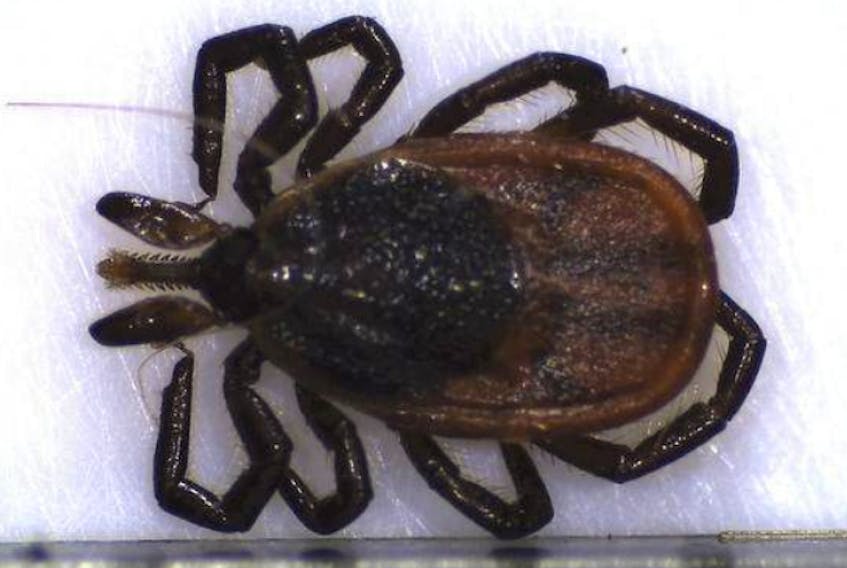Before she got Lyme disease, Sherry Veinot says she heeded every precaution to stay clear of ticks during search and rescue operations in Lunenburg County.
So did all the other members of the Lunenburg County Ground Search and Rescue team, said Veinot, the group’s search director and vice-president of the Nova Scotia Ground Search and Rescue Association. Despite their efforts, she and two other members of the group living in Bridgewater and LaHave areas were diagnosed with Lyme disease last summer, shortly after participating in a missing person search in Queens County.
“We did everything we could; protected ourselves with Deet, made sure we tied our pant cuffs to our boots, buttoned our shirt cuffs but it wasn’t enough,” said Veinot, a 30-year search and rescue volunteer. “A lot of our members found (black-legged) ticks on them when they got home, some found them even after they showered.
Veinot’s diagnosis came in last August during a visit to the Fishermen’s Memorial Hospital outpatient clinic in Lunenburg. She said she was flattened by the disease for weeks but antibiotics provided temporary relief. Veinot says the disease has re-emerged twice, most recently six weeks ago when she was given a three-week antibiotic prescription. She said the other two members who contracted the diseases were treated successfully with antibiotics and
haven’t had any flare-ups.
But she says the province is not taking measures to help protect the 1,260 association volunteers from the disease. The association’s 23 search and rescue teams fall under the jurisdiction of Emergency Management Office, a division of the Department of Justice. Veinot says members are provided no formal guidance from the province on how to protect themselves from Lyme disease, and other serious tickborne diseases. Some of them have purchased permethrincoated clothing at their own expense. Permethrin is a tick repellant insecticide.
Each of the search and rescue teams is allotted $3,000 in annual funding from the province to cover necessary expenses. The teams purchase their own clothing. Eight teams are without a building to store their gear and fundraise for basic equipment.
“We just want to know what the actual risk we’re facing. We want to know exactly what kind of ticks are out there and what diseases they are carrying.”
In Nova Scotia, all but Cape Breton Island andGuysborough County are deemed high-risk areasfor Lyme disease by the Department of Health andWellness. In 2016, the number of reported cases of the disease in the province rose to 326, up from 247 in 2015. That amounts to 34.4 per 100,000population, 12.7 times the national average.
Data for 2017 is not yet available.
Vett Lloyd, a Mount Allison University biologist and tick expert, says no other place in Canada rivals the ballooning tick population on the province’s South Shore, with Ontario being the possible exception.
Nova Scotians shouldn’t just be concerned about Borrelia burgdorferi, the bacteria which causes Lyme disease and is carried only by black-legged ticks.
A Dalhousie University study released in May shows blacklegged ticks carry more than just Borrelia burgdorferi. The study also sampled American dog ticks and found they also carried dangerous bacteria. All of the parasites were collected in Nova Scotia, and in one test of 115 blacklegged ticks, 20 carried Borrelia burgdorferi.
But 76 per cent of dog ticks and 40 per cent of black-legged ticks tested carried Bartonella, which causes endocarditis, and several other serious and potentially fatal diseases in humans. Rickettsia, which can cause Rocky Mountain Spotted Fever, was found in 53 per cent of dog ticks tested compared to 14 per cent in black-legged ticks. Some of the ticks also carried Francisellatularensis, a potentially deadly bacteria, andAnaplasma phagocytophilum, which caused tick borne fever The Department of Health and Wellness said it was unaware of the study but said the study is consistent with its own surveillance of ticks. Yet, similar data has not been made readily available to the public by the Department of Health and Wellness or any other provincial government department.
Veinot said the two search and rescue members who contracted the disease opened claims with the Workers’ Compensation Board of Nova Scotia. Because she’s retired, Veinot said she didn’t attempt to open a claim and got no financial support from the province. Her treatment was paid through her husband’s drug plan.
The Chronicle Herald inquired with Emergency Management Office, asking questions about whether the department was aware of the three Lyme disease cases and if measures are in place to protect search and rescue members from tick-borne diseases. None of the questions were answered directly. Spokeswoman Susan Mader-Zinck said the province maintains a tick safety website as a reference guide for residents but added no other information.
“The association would be best to provide information on the training and standards they follow regarding tick borne illnesses, including Lyme disease,” said Mader-Zinck.
Newly appointed Municipal Affairs Minister Chuck Porter sent a letter to the group last week promising to host a meeting with the association executives in the near future. Veinot hopes he’ll see to it that the association gets more provincial support.









